exactly... weird pattern like burn damage. Was thinking hot water at first, like hose or watering canThe tree appears chloritic, has dead and browning leaves from the tips, sides and base of some leaves, leaves are curled, some leathery and discolored…..
You are using an out of date browser. It may not display this or other websites correctly.
You should upgrade or use an alternative browser.
You should upgrade or use an alternative browser.
Need help with Azalea, Please!
- Thread starter Balakeh
- Start date
Balakeh
Seedling
Are we able to rule out root rot as the cause then and do I need to continue the H2O2 treatment throughout the week and every other week?The latest Yorba Linda AWQ Report shows 16 grains/gallon or 274 ppm. CaCO3. Yep, your water is very hard. Th pH is 8.1, borderline for your . So it’s a hardness issue
- Good on the Hydrogen Peroxide treatment.
- Also, arrange to have the tree under shade cloth, but give it only early morning sun. Mist the leaves often. Remove dead leaves.
- The water hardness needs to be addressed soon. An easy start would be to get Miracid fertilizer (Not Miracle Gro!) and distilled water. The add Miracid fertilizer 1/4 Teaspoon per gallon of water when watering. This ought to solve the issue, but will be a bit pricey buying distilled water over the long term.
More on this on the next post.
cheers
DSD sends
The tree is currently under a shade cloth that blocks 70-80% of the sun. Do I keep it here for mornings only and then move it to full shade?
Also, is it miracid by miracle gro or what brand makes the Miracid? I was not able to find anything besides the miracle gro.
Thank you very much for the information,
Blake
Pitoon
Imperial Masterpiece
I know @yenling83 recently installed a R/O system to water his plants. Maybe he has some advice in regards to the water quality.
Pitoon
Imperial Masterpiece
Miracid is made by Miracle-go. There's some new containers out in circulation.Also, is it miracid by miracle gro or what brand makes the Miracid? I was not able to find anything besides the miracle gro.
Deep Sea Diver
Imperial Masterpiece
@Pitoon is right on. The new label Says Miracle Gro for Azaleas, Cammellias and Rhododendrens. It’s at the East Brea Home Depot (Aisle 01, Bay 001)
So the issue is a cascade of events occurs when a tree becomes weakened, so root issues are certainly in play. (Also spray the leaves.
The Hydrogen Peroxide treatment does two things. I think it’s safe to
1. Oxygenates the soil
2. Acts as an antiseptic.
and more to come…
Cheers
DSD sends
So the issue is a cascade of events occurs when a tree becomes weakened, so root issues are certainly in play. (Also spray the leaves.
The Hydrogen Peroxide treatment does two things. I think it’s safe to
1. Oxygenates the soil
2. Acts as an antiseptic.
and more to come…
Cheers
DSD sends
Balakeh
Seedling
Do I spray the leaves with the H2O2 mix or just with regular water?@Pitoon is right on. The new label Says Miracle Gro for Azaleas, Cammellias and Rhododendrens. It’s at the East Brea Home Depot (Aisle 01, Bay 001)
So the issue is a cascade of events occurs when a tree becomes weakened, so root issues are certainly in play. (Also spray the leaves.
The Hydrogen Peroxide treatment does two things. I think it’s safe to
1. Oxygenates the soil
2. Acts as an antiseptic.
and more to come…
Cheers
DSD sends
Deep Sea Diver
Imperial Masterpiece
Yes, spray the leaves once every other day. After a week step it down to 2 TBSP every 3 days.
(Actually I use 2 TBSP H2O2 with the small side scoop that comes with Miracid per Qt water every 3 days on all my azaleas.)
Short term -
1/4 teaspoon Miracid in gallon Distilled water (not filtered).
Hopefully this will slowly solve the situation. Yet the conditions will likely get worse first. Once an azalea crashes, in my experience it takes a long time weeks-months to turn around.
Long term - switch once things look stable
- purchase a good chelating agent so one can use this with the Yorba Linda tap water.
- Given the tree is healthy in the New Year when the weather breaks, switch the media to Kanuma. Kanuma is acidic about 5.5 pH.
- Fertilize with Miracid (Labelled now as Miracle Gro for Azaleas) on a regular basis, every twoish weeks (except when really hot) through fall.
cheers
DSD sends
(Actually I use 2 TBSP H2O2 with the small side scoop that comes with Miracid per Qt water every 3 days on all my azaleas.)
Short term -
1/4 teaspoon Miracid in gallon Distilled water (not filtered).
Hopefully this will slowly solve the situation. Yet the conditions will likely get worse first. Once an azalea crashes, in my experience it takes a long time weeks-months to turn around.
Long term - switch once things look stable
- purchase a good chelating agent so one can use this with the Yorba Linda tap water.
The best long lasting chelating agent I know contains EDDTA. Here is a link to a product of this type. You should add this to your water every time youwater.
(Some folks here like @cmeg1 and @Leo in N E Illinois might have some helpful thoughts too)
- Given the tree is healthy in the New Year when the weather breaks, switch the media to Kanuma. Kanuma is acidic about 5.5 pH.
- Fertilize with Miracid (Labelled now as Miracle Gro for Azaleas) on a regular basis, every twoish weeks (except when really hot) through fall.
cheers
DSD sends
Balakeh
Seedling
I appreciate your help very much.Yes, spray the leaves once every other day. After a week step it down to 2 TBSP every 3 days.
(Actually I use 2 TBSP H2O2 with the small side scoop that comes with Miracid per Qt water every 3 days on all my azaleas.)
Short term -
1/4 teaspoon Miracid in gallon Distilled water (not filtered).
Hopefully this will slowly solve the situation. Yet the conditions will likely get worse first. Once an azalea crashes, in my experience it takes a long time weeks-months to turn around.
Long term - switch once things look stable
- purchase a good chelating agent so one can use this with the Yorba Linda tap water.
The best long lasting chelating agent I know contains EDDTA. Here is a link to a product of this type. You should add this to your water every time youwater.
(Some folks here like @cmeg1 and @Leo in N E Illinois might have some helpful thoughts too)
- Given the tree is healthy in the New Year when the weather breaks, switch the media to Kanuma. Kanuma is acidic about 5.5 pH.
- Fertilize with Miracid (Labelled now as Miracle Gro for Azaleas) on a regular basis, every twoish weeks (except when really hot) through fall.
cheers
DSD sends
I am just wondering why this problem would arise now if it’s due to my tap water being too alkaline? Wouldn’t this issue have happened sooner if I have had the tree for almost a year now?
also, how do I make sure it isn’t due to root rot or a fungi infecting the plants roots?
waydeo
Mame
Deep sea Diver could I impose on you to enlighten some of us azalea newbies with a tutorial on how to care for our azaleas, maybe make it a sticky or care sheet to send people to. If there is a link it would be helpful . Maybe I missed it searching if there is one. Thanks
Edit ,I found it.
Edit ,I found it.
Evergreen Azalea Basics, including Satsuki Version 1.01
Last edited:
Paradox
Marine Bonsologist
I would be careful about wetting the foliage too often. Azaleas do not like to have their foliage wet alot. It promotes fungus. Also, the heavy soil mix may be staying too wet which they don't like either. They like a well draining mix that doesn't stay too wet but also doesn't dry out completely.
I also think it could be a combination of things. I've seen Azaleas go bad like this with brown leaves. Unfortunately it usually didn't end well.
Good luck getting it healthy again
I also think it could be a combination of things. I've seen Azaleas go bad like this with brown leaves. Unfortunately it usually didn't end well.
Good luck getting it healthy again
Deep Sea Diver
Imperial Masterpiece
That’s an awfully good question. Since you are new, I will give you a complete rundown on most everything I’m thinking.
If you choose not to follow the advice, that’s ok with me. After all, your tree - your choice.
The short answer is I absolutely don’t know for sure exactly what is bugging your tree. It seems to be affected by a cascade of events over time. Likely only a horticulturist specializing in azaleas, perhaps someone in the industry with specialized equipment could deduce exactly what is wrong with thus azalea.
Yet we do have about 120 medium azaleas and numerous (over 300) 2-3 yoa azaleas I work with most every day. Amazingly, I learn things from them.
This is what I do know.
- The tree Is showing multiple symptoms, including, chlorosis, nutrient deficiency, possible underwatering/over fertilizing, ossifying branches etc.
- The tree hasn’t been through a summer with you and it’s been potted in organic mix, pH unk, kept in full sun/ 70% shade cloth
- Yorba Linda’s water is very hard, mildly alkaline.
- watering regime was every two days
- The weather is hot.
- Someone might of watered your tree too much for five days.
- The tree hasn’t been fertilized for 30 days until yesterday. The 12-4-5 fertilizer used has extra Ca, Mg, Fe
Here’s what I think
1. Likely not root rot, bit just in case should be treated as root rot is present. That’s why H2O2 was recommended as it has successfully used been on a number of trees to solve root issues.
Why not likely? Because as @Shibui mentions it takes a long time to develop.
See photo of an ongoing root rot experiment presently being done out back on two different cultivar azaleas below.
Azalea on right has been submerged for over 30 days with no signs of root rot. This included two periods of 95F.
Azalea on left was also submerged. It got root rot at 22 days and is now being treated with H2O2 in an attempt to nurse it back to health. Note leave tips on left tree.

2. Azaleas who normally live in an acid environment, can produce a neutralizing barrier around their roots to help with high pH to some extent. Yet over time and under stress the tree‘s protection will eventually be overcome. The Fe in the fertilizer likely helped to stave this off and maybe the soil if it’s pH is low, but the hard water, maybe the missed fertilization and continually hot summer temperatures likely eventually stressed the tree over its limit. There is no doubt the roots were damaged in this event. Damage in the leaves shows this to be so.
What do I think should be done?
Just what I posted.
a. Treat for root issues with a short lasting fungicide H2O2. Get tree out of sun in afternoons/evening. Mist.
b. Fix the water issue quickly by using distilled water and add a small dose of acidifying fertilizer with micronutrients
c. Provide a long term solution by adding a good long acting chelating agent to OP’s tap water and continue acifiying fertilizer.
What do I think will happen?
The tree is in the ICU in a deteriorating state. Condition is grave. Prognosis unknown.
Once again, your tree, your choice.
Cheers
DSD sends
If you choose not to follow the advice, that’s ok with me. After all, your tree - your choice.
The short answer is I absolutely don’t know for sure exactly what is bugging your tree. It seems to be affected by a cascade of events over time. Likely only a horticulturist specializing in azaleas, perhaps someone in the industry with specialized equipment could deduce exactly what is wrong with thus azalea.
Yet we do have about 120 medium azaleas and numerous (over 300) 2-3 yoa azaleas I work with most every day. Amazingly, I learn things from them.
This is what I do know.
- The tree Is showing multiple symptoms, including, chlorosis, nutrient deficiency, possible underwatering/over fertilizing, ossifying branches etc.
- The tree hasn’t been through a summer with you and it’s been potted in organic mix, pH unk, kept in full sun/ 70% shade cloth
- Yorba Linda’s water is very hard, mildly alkaline.
- watering regime was every two days
- The weather is hot.
- Someone might of watered your tree too much for five days.
- The tree hasn’t been fertilized for 30 days until yesterday. The 12-4-5 fertilizer used has extra Ca, Mg, Fe
Here’s what I think
1. Likely not root rot, bit just in case should be treated as root rot is present. That’s why H2O2 was recommended as it has successfully used been on a number of trees to solve root issues.
Why not likely? Because as @Shibui mentions it takes a long time to develop.
See photo of an ongoing root rot experiment presently being done out back on two different cultivar azaleas below.
Azalea on right has been submerged for over 30 days with no signs of root rot. This included two periods of 95F.
Azalea on left was also submerged. It got root rot at 22 days and is now being treated with H2O2 in an attempt to nurse it back to health. Note leave tips on left tree.

2. Azaleas who normally live in an acid environment, can produce a neutralizing barrier around their roots to help with high pH to some extent. Yet over time and under stress the tree‘s protection will eventually be overcome. The Fe in the fertilizer likely helped to stave this off and maybe the soil if it’s pH is low, but the hard water, maybe the missed fertilization and continually hot summer temperatures likely eventually stressed the tree over its limit. There is no doubt the roots were damaged in this event. Damage in the leaves shows this to be so.
What do I think should be done?
Just what I posted.
a. Treat for root issues with a short lasting fungicide H2O2. Get tree out of sun in afternoons/evening. Mist.
b. Fix the water issue quickly by using distilled water and add a small dose of acidifying fertilizer with micronutrients
c. Provide a long term solution by adding a good long acting chelating agent to OP’s tap water and continue acifiying fertilizer.
What do I think will happen?
The tree is in the ICU in a deteriorating state. Condition is grave. Prognosis unknown.
Once again, your tree, your choice.
Cheers
DSD sends
penumbra
Imperial Masterpiece
Unless it has H2O2 in it. Then it kills fungal spores.Azaleas do not like to have their foliage wet alot. It promotes fungus.
Balakeh
Seedling
I will definitely take your advice and follow your steps. I already purchased a few gallons of distilled water as well as the miracle gro Miracid. I applied the mixture this evening to the soil.That’s an awfully good question. Since you are new, I will give you a complete rundown on most everything I’m thinking.
If you choose not to follow the advice, that’s ok with me. After all, your tree - your choice.
The short answer is I absolutely don’t know for sure exactly what is bugging your tree. It seems to be affected by a cascade of events over time. Likely only a horticulturist specializing in azaleas, perhaps someone in the industry with specialized equipment could deduce exactly what is wrong with thus azalea.
Yet we do have about 120 medium azaleas and numerous (over 300) 2-3 yoa azaleas I work with most every day. Amazingly, I learn things from them.
This is what I do know.
- The tree Is showing multiple symptoms, including, chlorosis, nutrient deficiency, possible underwatering/over fertilizing, ossifying branches etc.
- The tree hasn’t been through a summer with you and it’s been potted in organic mix, pH unk, kept in full sun/ 70% shade cloth
- Yorba Linda’s water is very hard, mildly alkaline.
- watering regime was every two days
- The weather is hot.
- Someone might of watered your tree too much for five days.
- The tree hasn’t been fertilized for 30 days until yesterday. The 12-4-5 fertilizer used has extra Ca, Mg, Fe
Here’s what I think
1. Likely not root rot, bit just in case should be treated as root rot is present. That’s why H2O2 was recommended as it has successfully used been on a number of trees to solve root issues.
Why not likely? Because as @Shibui mentions it takes a long time to develop.
See photo of an ongoing root rot experiment presently being done out back on two different cultivar azaleas below.
Azalea on right has been submerged for over 30 days with no signs of root rot. This included two periods of 95F.
Azalea on left was also submerged. It got root rot at 22 days and is now being treated with H2O2 in an attempt to nurse it back to health. Note leave tips on left tree.
View attachment 450671
2. Azaleas who normally live in an acid environment, can produce a neutralizing barrier around their roots to help with high pH to some extent. Yet over time and under stress the tree‘s protection will eventually be overcome. The Fe in the fertilizer likely helped to stave this off and maybe the soil if it’s pH is low, but the hard water, maybe the missed fertilization and continually hot summer temperatures likely eventually stressed the tree over its limit. There is no doubt the roots were damaged in this event. Damage in the leaves shows this to be so.
What do I think should be done?
Just what I posted.
a. Treat for root issues with a short lasting fungicide H2O2. Get tree out of sun in afternoons/evening. Mist.
b. Fix the water issue quickly by using distilled water and add a small dose of acidifying fertilizer with micronutrients
c. Provide a long term solution by adding a good long acting chelating agent to OP’s tap water and continue acifiying fertilizer.
What do I think will happen?
The tree is in the ICU in a deteriorating state. Condition is grave. Prognosis unknown.
Once again, your tree, your choice.
Cheers
DSD sends
The tree is definitely in the ICU, I agree. Where I am curious is why the issue of the leaves turning black and brown/falling off started in just one area of the tree three weeks ago and now it has spread to the whole tree.
I definitely think it’s an issue with the roots and them not being able to bring enough water or nutrients to the leaves, therefore the leaves are losing thickness, color, and dying. Some of the leaves just become soft, like they are lacking water.
I brought it by a local bonsai nursery and they weren’t much help. They suspected underwatering at first but I told them that I think it’s due to the PH level. They recommended repotting it in Kanuma when (and if) it is healthy again.
I added some more photos of the leaves that were taken this evening. The tree probably lost 40-60 leaves just today.
Attachments
-
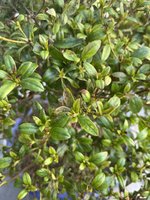 11278A3C-0483-43BA-9C8E-4C21D736B573.jpeg207.5 KB · Views: 31
11278A3C-0483-43BA-9C8E-4C21D736B573.jpeg207.5 KB · Views: 31 -
 3E411743-1AC1-4771-9F7C-D29584CB957F.jpeg188.4 KB · Views: 22
3E411743-1AC1-4771-9F7C-D29584CB957F.jpeg188.4 KB · Views: 22 -
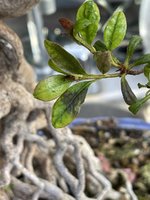 D2FAABCA-4E4A-4A3E-9CD0-A2721B939A03.jpeg149 KB · Views: 16
D2FAABCA-4E4A-4A3E-9CD0-A2721B939A03.jpeg149 KB · Views: 16 -
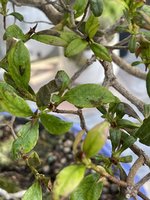 5C9E981C-3FDB-4DC4-B089-A428C5741C8A.jpeg185.3 KB · Views: 18
5C9E981C-3FDB-4DC4-B089-A428C5741C8A.jpeg185.3 KB · Views: 18 -
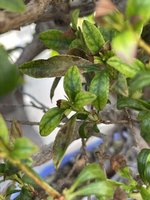 18FCF0E0-03A1-4D19-B89F-22DFB916C174.jpeg159.4 KB · Views: 30
18FCF0E0-03A1-4D19-B89F-22DFB916C174.jpeg159.4 KB · Views: 30
Deep Sea Diver
Imperial Masterpiece
Have faith, where there is life, there is hope! Azaleas ain’t no Shrinking Violets.
Please let us know how things progress.
cheers
DSD sends
Please let us know how things progress.
cheers
DSD sends
sorce
Nonsense Rascal
It's an Azalea....
Welcome to Crazy!
If you're not gonna plant it somewhere in the yard....burn it, like with gas and matches burn it.
Sorce
Welcome to Crazy!
If you're not gonna plant it somewhere in the yard....burn it, like with gas and matches burn it.
Sorce
Balakeh
Seedling
I was wondering what your thoughts were about replacing the top inch or so of soil with Kanuma? I was going to pick some up from my local store to try and help with the acidity level and new root growth.Have faith, where there is life, there is hope! Azaleas ain’t no Shrinking Violets.
Please let us know how things progress.
cheers
DSD sends
also, would moving the tree inside when it becomes 90-95+ out and very windy be a smart idea? The weather has been brutal here. Feels like the desert
Deep Sea Diver
Imperial Masterpiece
Not sure about this. Probably better to add some chelating agent to the distilled water.
At some point the excess minerals in the media will be locked up and things should get better.
Likely not a good idea to bring in the tree if you have a/c. That would cause a whole slew of issues…light. humidity, acclimation both taking the tree both in and out later... Usually azaleas respond in a two to four week window when conditions change to the positive…
Is it possible to move the tree to more shade and water down the ground underneath, mist and wrap a wet towel around the pot to keep the media cooler… and make sure the foliage dries before sun down… or is this something you have done already?.
Cheers
DSD sends
At some point the excess minerals in the media will be locked up and things should get better.
Likely not a good idea to bring in the tree if you have a/c. That would cause a whole slew of issues…light. humidity, acclimation both taking the tree both in and out later... Usually azaleas respond in a two to four week window when conditions change to the positive…
Is it possible to move the tree to more shade and water down the ground underneath, mist and wrap a wet towel around the pot to keep the media cooler… and make sure the foliage dries before sun down… or is this something you have done already?.
Cheers
DSD sends
Balakeh
Seedling
Good morning fellow Bonsai lovers,Not sure about this. Probably better to add some chelating agent to the distilled water.
At some point the excess minerals in the media will be locked up and things should get better.
Likely not a good idea to bring in the tree if you have a/c. That would cause a whole slew of issues…light. humidity, acclimation both taking the tree both in and out later... Usually azaleas respond in a two to four week window when conditions change to the positive…
Is it possible to move the tree to more shade and water down the ground underneath, mist and wrap a wet towel around the pot to keep the media cooler… and make sure the foliage dries before sun down… or is this something you have done already?.
Cheers
DSD sends
I just wanted to share an update about how my azalea is doing. I posted it back on august 12th.
Currently the azalea has lost most of its foliage. There are bare branches and the tree is not looking good at all. It’s looking pretty dead but there is still some hope.
I have been watering it with distilled water ever since august and I have added 1/4 tbs of Miracid to the gallon of water. The tree shed most of its foliage but there is a ton of new growth starting to form, yet very small. I would have assumed the tree would be dead by now if it had root rot, correct?
It was 95-105 degrees for about 2 weeks straight so it has been really hard for the azalea to rebound. It is not comfortable with this harsh weather seeing that it came from Mississippi about a year ago.
My only issue now is that sometimes the new growth will turn brown or black at the tip of the leaf or the whole leaf will turn brown/black as well as curl up and fall off. I am not sure why this is? New growth sometimes dies very easily.
I am wondering if I should try a final move to try and save it by reporting it in Kanuma & sphagnum moss?
I have attached some more photos of the azalea to this post incase anyone wants to look at it. Trust me, I know it doesn’t look good.
Attachments
-
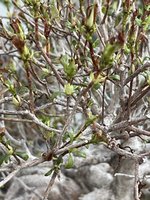 CCCF8720-E246-4426-97DD-19D59CBD6796.jpeg259.5 KB · Views: 15
CCCF8720-E246-4426-97DD-19D59CBD6796.jpeg259.5 KB · Views: 15 -
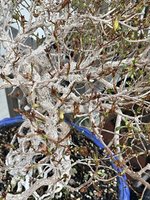 FFE5C579-159E-4E96-9977-AA4ABF1BC5FB.jpeg358.4 KB · Views: 14
FFE5C579-159E-4E96-9977-AA4ABF1BC5FB.jpeg358.4 KB · Views: 14 -
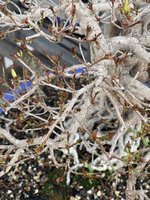 6F8EEC76-9C09-47A0-966F-36D5BB8125A0.jpeg270.8 KB · Views: 12
6F8EEC76-9C09-47A0-966F-36D5BB8125A0.jpeg270.8 KB · Views: 12 -
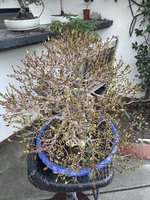 15167247-6CA8-4D23-BC91-D64208ACE162.jpeg353.1 KB · Views: 11
15167247-6CA8-4D23-BC91-D64208ACE162.jpeg353.1 KB · Views: 11 -
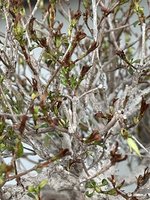 45970DB5-EDA0-4902-963B-EFCE01B94726.jpeg283.2 KB · Views: 12
45970DB5-EDA0-4902-963B-EFCE01B94726.jpeg283.2 KB · Views: 12 -
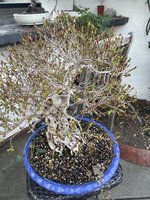 9649A1D6-2023-472A-BC0F-760A8B8544CA.jpeg358.6 KB · Views: 15
9649A1D6-2023-472A-BC0F-760A8B8544CA.jpeg358.6 KB · Views: 15 -
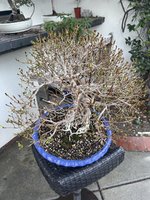 30E26B1B-26B6-4656-8076-59C35D291812.jpeg337.5 KB · Views: 16
30E26B1B-26B6-4656-8076-59C35D291812.jpeg337.5 KB · Views: 16 -
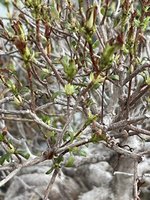 CB0B7E91-DA09-41A4-A836-00D70BD8B104.jpeg271.8 KB · Views: 17
CB0B7E91-DA09-41A4-A836-00D70BD8B104.jpeg271.8 KB · Views: 17
Glaucus
Omono
If it is backbudding now, and I think I can see a few but the pictures are not super clear, then that strongly suggests it was too dry and or too hot acutely.
And then indeed it is not root rot.
Since you see it is now starting to get better, I would just do nothing and let it improve on it's own.
Depending on how much growing season you have left, I would repot it maybe at the end of winter into a more horticulture-leaning pot.
That repot hopefully will fix any issues you may have with drainage, remove the dead roots it may have, and a larger pot will make it easier for the plant to not get stressed as fast.
Small pot & hot weather means drought or heat stress is just around the corner.
You first need to get this one strong and healthy again. And make sure the same thing doesn't happen again.
Then probably after the repot somewhere in late spring you can go in and cut out all the dead twigs.
Then at the end of one full growing season, you can take a look and see how you can get this back on a bonsai trajectory.
If a large branch for example did completely die with no backbudding, it means that part of the trunk and that part of the root system may die. Losing a large branch on an azalea may mean you get a hollow trunk eventually.
And then indeed it is not root rot.
Since you see it is now starting to get better, I would just do nothing and let it improve on it's own.
Depending on how much growing season you have left, I would repot it maybe at the end of winter into a more horticulture-leaning pot.
That repot hopefully will fix any issues you may have with drainage, remove the dead roots it may have, and a larger pot will make it easier for the plant to not get stressed as fast.
Small pot & hot weather means drought or heat stress is just around the corner.
You first need to get this one strong and healthy again. And make sure the same thing doesn't happen again.
Then probably after the repot somewhere in late spring you can go in and cut out all the dead twigs.
Then at the end of one full growing season, you can take a look and see how you can get this back on a bonsai trajectory.
If a large branch for example did completely die with no backbudding, it means that part of the trunk and that part of the root system may die. Losing a large branch on an azalea may mean you get a hollow trunk eventually.
Balakeh
Seedling
The tree definitely has back budding but I am still having issues with the leaves browning or blackening at the tips, then completely, and then they fall off.
Most of the leaves turn brown/dry, it is an issue I am continuing to have. Even some of the new growth has quickly turned brown and died.
I did a bit of light digging through the top soil and around the edges of the pot and noticed there were quite a few dead roots. I would lightly scrape the root to see if there was any green and for the most part a lot of roots did not have green. I am wondering if the soil is too wet now.
Is there any last ditch effort I can do to try and save the tree? @deepseadiver
Most of the leaves turn brown/dry, it is an issue I am continuing to have. Even some of the new growth has quickly turned brown and died.
I did a bit of light digging through the top soil and around the edges of the pot and noticed there were quite a few dead roots. I would lightly scrape the root to see if there was any green and for the most part a lot of roots did not have green. I am wondering if the soil is too wet now.
Is there any last ditch effort I can do to try and save the tree? @deepseadiver
Similar threads
- Replies
- 5
- Views
- 4K
- Replies
- 13
- Views
- 3K
